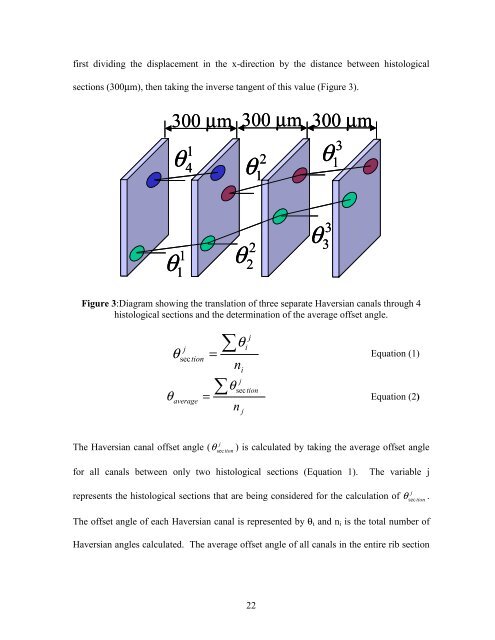Microstructural And Mechanical Properties Of Human Ribs Joseph
Microstructural And Mechanical Properties Of Human Ribs Joseph
Microstructural And Mechanical Properties Of Human Ribs Joseph
You also want an ePaper? Increase the reach of your titles
YUMPU automatically turns print PDFs into web optimized ePapers that Google loves.
first dividing the displacement in the x-direction by the distance between histological<br />
sections (300µm), then taking the inverse tangent of this value (Figure 3).<br />
300 µm 300 µm 300 µm<br />
θθ<br />
θθ<br />
1<br />
1<br />
1<br />
4<br />
θθ<br />
θθ<br />
2<br />
2<br />
22<br />
2<br />
1<br />
θθ<br />
θθ<br />
Figure 3:Diagram showing the translation of three separate Haversian canals through 4<br />
histological sections and the determination of the average offset angle.<br />
θ<br />
j<br />
θsec tion<br />
average<br />
=<br />
=<br />
∑<br />
∑<br />
θ<br />
n<br />
j<br />
θ<br />
i<br />
j<br />
j<br />
i<br />
section<br />
n<br />
3<br />
3<br />
3<br />
1<br />
Equation (1)<br />
Equation (2)<br />
j<br />
The Haversian canal offset angle ( θ ) is calculated by taking the average offset angle<br />
sec tion<br />
for all canals between only two histological sections (Equation 1). The variable j<br />
j<br />
represents the histological sections that are being considered for the calculation of θ .<br />
sec tion<br />
The offset angle of each Haversian canal is represented by θι and ni is the total number of<br />
Haversian angles calculated. The average offset angle of all canals in the entire rib section



